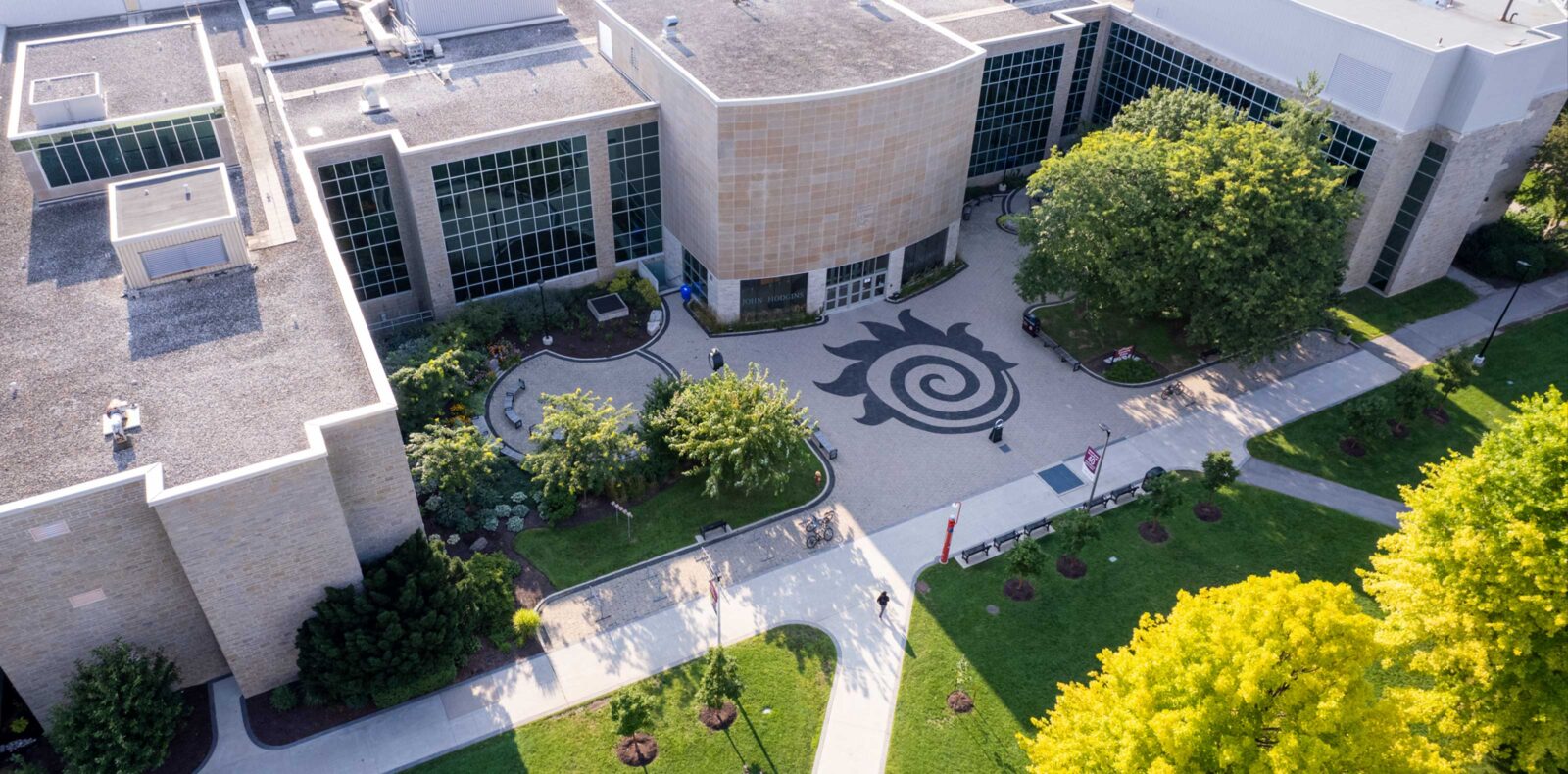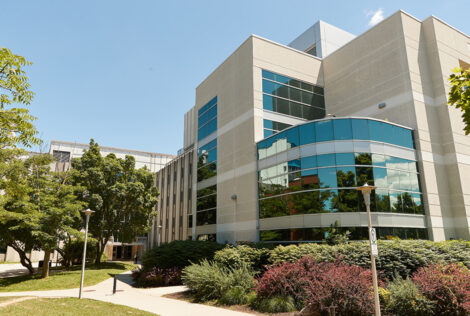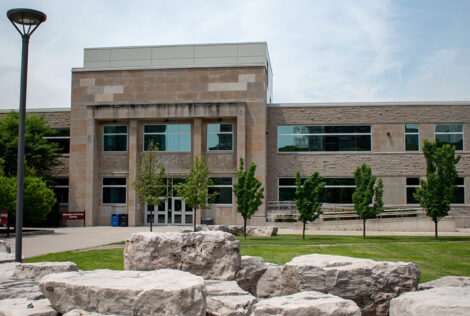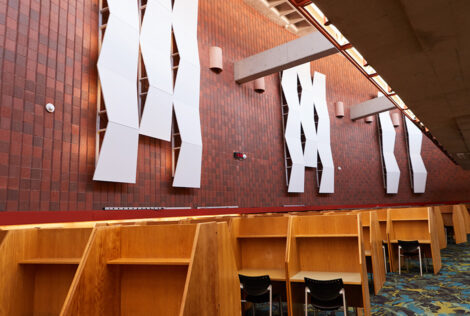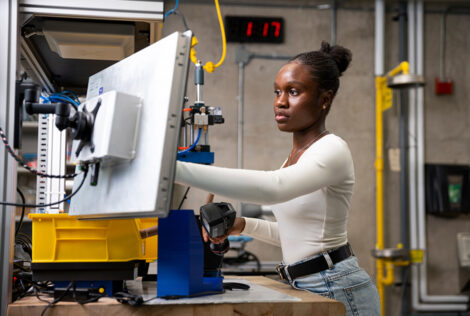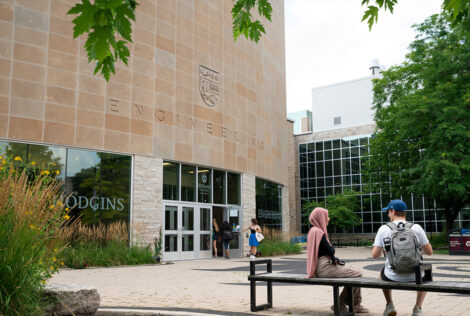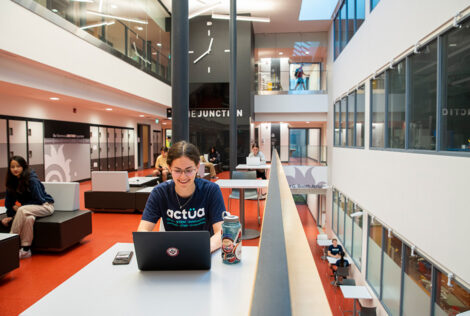
Want to learn more about the Mac Eng experience?
Daydreaming about what it would be like to be on campus?
In this DIY Tour, you’ll have a chance to check out the various Faculty of Engineering buildings, student spaces, support services, and classrooms on your own.
Faculty of Engineering locations
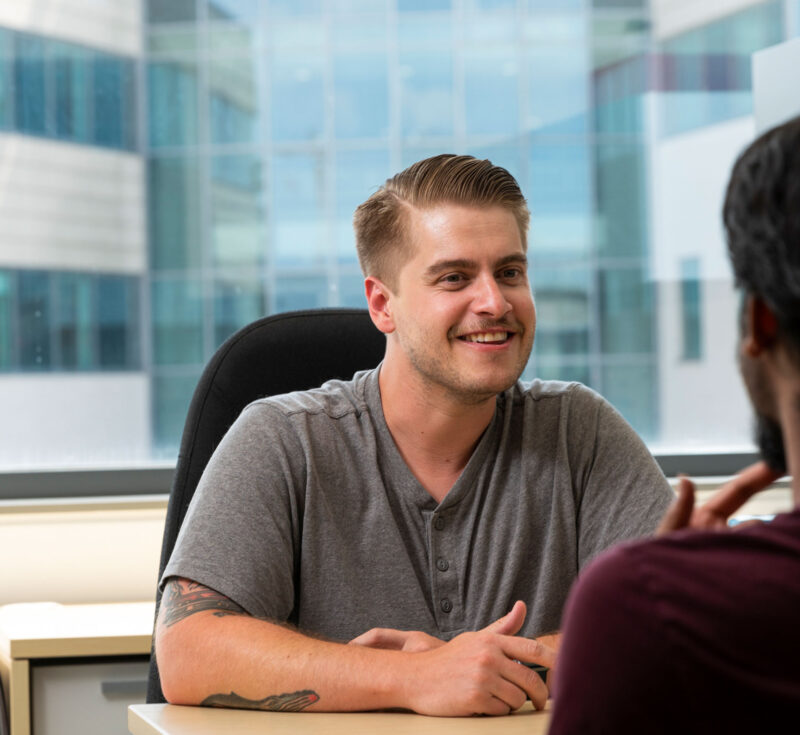
Book an in-person tour
Join us on campus.
If you want to book an in-person tour led by current student ambassadors, please book your tour below.
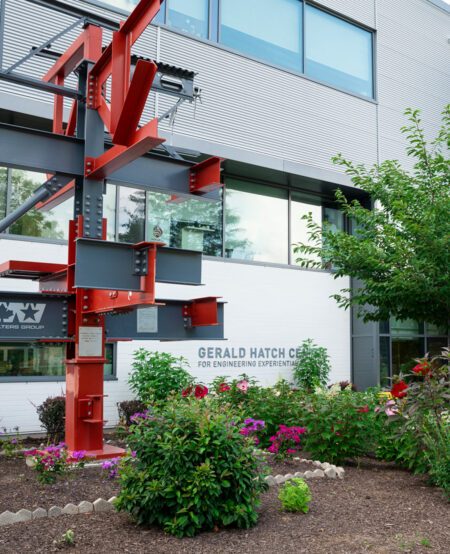
Gerald Hatch Centre
This building was designed by students, for students, holding lounge and study areas, meeting rooms for clubs and teams, a student workshop, and a garage for our technical engineering teams.
On the first floor, you will find The Drain. This student volunteer-run hub acts as a student store and help desk. Students can buy engineering swag, social events and networking event tickets from the Drain. You can also access the Hatch Buildspace & Garage from the main floor.
The second floor is home to The Junction, an open concept space for studying and socializing, but often used for various events such as co-op-focused industry nights, video game tournaments, or even academic help sessions
On the third floor of this building, we have some of our student service offices, Academic Advising and the Centre for Career Growth and Experience (the Centre). The office is broken down into two sections. On the left, you have access to engineering co-op resources, and on the right is the Academic Advising office.
1. The Centre for Career Growth and Experience (the Centre):
Co-op is available to all of our four programs – optional for CompSci, Eng & iBioMed, and mandatory for BTech students. If you were interested in co-op and wanted to obtain your co-op designation, you would need to complete a minimum of 12 months of relevant work experience prior to graduating. Our co-op program is considered flexible in terms of when and for how long you take your co-op positions – you can take 4,8-,12- or 16-month long co-op positions for when it makes sense for you.
The Centre is readily available to provide support and guidance for every step in the job application process. During your first year you’ll complete an “Intro to Co-op” course which teaches you all about how to boost and manage your resume, how to write a cover letter, what employers are looking for in interviews, what industries are available for our students and how they can tailor their background towards that future. Similarly, the office also offers resume & cover letter critiques, mock interviews, and career-building workshops and manage a job board only accessible to our students. The Centre also hosts over 100 events annually on-campus and virtually giving you the opportunity to engage, network and find your potential future employer.
2. Academic Advising office:
Academic Advising is like high school guidance counsellors. They can help you with course enrolment and the selection of any academic-based goal like a minor or certain specialization in your upper years. If you ever require tutoring or extra help with anything, they have those kinds of resources available as well. We highly recommend you to connect with our academic advisors throughout your time in school – the better they know you, the better advice they can provide – and not just go there in moments of panic or crisis.
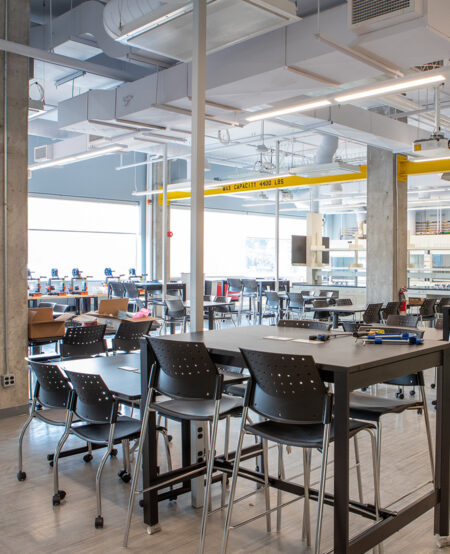
A.N. Bourns Science Building
Here you can find various lecture halls, tutorials, and labs that may be part of your academic schedule. The combination of the three for any of your subjects may vary from course to course.
Lecture: A formal presentation conducted by your lecturer on the content of the course, and you can find yourself in a lecture hall similar to this one or they could be in larger or smaller sizes depending on the course. The largest lecture hall on campus has 640 seats (found in PGCLL)
- Example in ABB: Mid-size lecture hall Room 102 (capacity of 197)
Tutorials: Smaller classes outside of your lectures which allow discussion of lecture content and assignments
Labs: Smaller class sizes that take your in-class learning and integrate them into hands-on learning opportunities
- Example in ABB: Chemistry Lab Room 112
- Example in ABB (part of the Innovation Tower): iBioMed Design Studio first floor
In the Faculty of Engineering, we have a large focus on experiential learning and our ABB Innovation Tower was built with this focus in mind.
The Innovation Tower is home to some of our design studio spaces for Engineering (upper floors) and iBioMed (first floor) students. These design studios are equipped with 3D printers, workspaces focused on collaboration and other technologies to support the creation of innovative designs as part of the courses being taken.
The Integrated Cornerstone Design Projects in Engineering (ENG 1P13) is a mandatory first-year course in the Engineering program. The year-long course combines four previously separate courses required for first-year engineering students: computing and programming, materials science, computer-aided design and profession and practice.
Health Solutions Design Projects I: Introduction to Engineering Fundamentals and Design (IBEHS 1P10) is a very similar mandatory course for the iBioMed first-year students but the projects are simulated in healthcare environments.
At the end of these courses, students enter the summer with an impressive online portfolio of projects they’ve built from the ground up, showing off their tangible experiences with coding, design, materials, and teamwork.
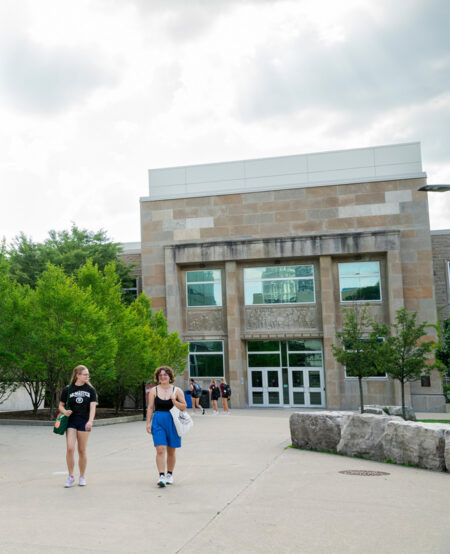
Information Technology Building
In the Information Technology Building, you can primarily find lecture and tutorial rooms, but also some neat research spaces.
This is a graduate-level lab run by the electrical and computer engineering department. A recent project from this space was called the “Octo-Drone” – this project works to make the drone autonomously aware of its location and any of its surroundings with the help of the red sensors placed in the ceilings. Another project (the more cubic-shaped drone) is meant to be multi-directional in flight. Most drones only fly up and down and ‘wobble’ to go in any given direction. This drone has 8 propellers oriented in different directions; this allows it to fly in very precise movements without losing propulsion.
A collaborative lab used by psychology and software engineering/computer science. Our students program the simulator to recreate the experience of driving, flying, falling (etc.) and the psychology students equip participants with EEG readers to measure their brain activity and how they’re responding to the simulation.
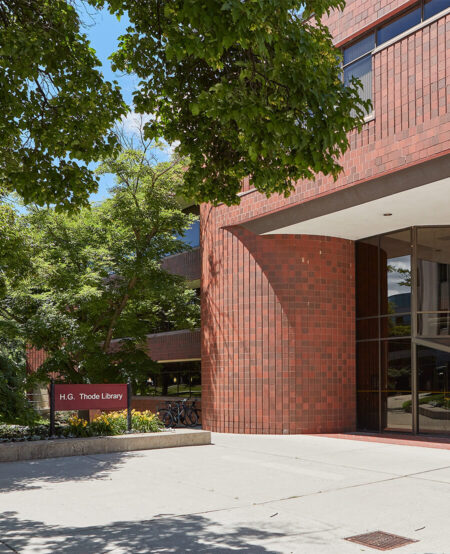
H.G. Thode Library of Science and Engineering
There are a few libraries on campus, and you’re welcome to study in any of them. However, Thode is our engineering- and science-focused library that hosts resources for students in the engineering and science programs.
Across most libraries, there are different levels of volume/types of study designated to specific areas of the libraries. At Thode, the first floor is focused on group work with desks facing each other, the second floor is focused on more solo work with dividers between most workspaces, and the basement is for those who prefer to study in complete silence.
Found in the basement of Thode, the Makerspace is a space for students to explore using some more hands-on tools and technologies to pursue personal interests or passion projects, whether it’s a hand-made gift or a start-up idea. The space is free to use for ALL students (regardless of program) with sewing machines, 3D printers, shop tools, soldering, laser cutting and more available for use! Much like the Engineering workshop previously seen in the Hatch building, many students come to work on capstone projects, or related project works for courses.
The space is a joint collaboration with The Forge, McMaster’s start-up incubator which holds pitch competitions and provides space for start-up companies or those interested in entrepreneurship. A handful of companies powered by The Forge work out of the McMaster Innovation Park, just a short drive down the road from McMaster.
A Technical Advisor is always on site in the Makerspace to assist with any projects or provide training to use certain tools. They also provide Arduinos or Raspberry Pi’s to rent out like library books to work on projects at home. Workshops are also held in this space every few weeks to provide insight on certain software or tools in the space.
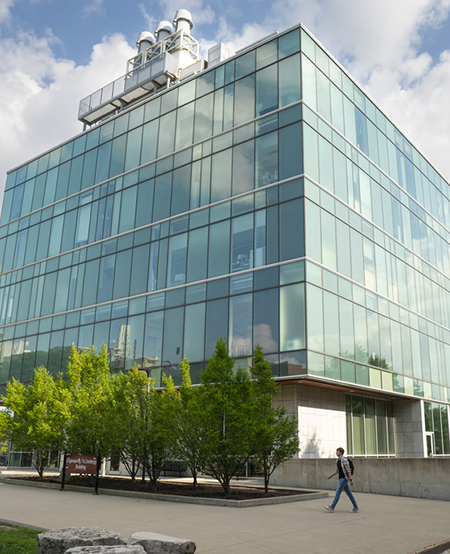
Engineering Technology Building
Engineering Technology Building (ETB) is home to many different students and staff from all of our MacEng undergraduate programs as well as the Centre for Research in Micro- and Nano-Systems and houses a number of lab spaces used by our BTech students.
Equipped with oscilloscopes, various components for breadboards, and computers with design software loaded, this lab allows students to learn all about how electrical components work in circuitry and larger industrial systems.
The Bachelor of Technology students are the only undergraduates on campus who complete training for the biohazard level 2 labs. This lab highlights the type of work and experiments done by upper-year Biotechnology students.
This space has been made with industry standards in mind. It is meant to function as a full assembly line so that graduating students can complete their cumulative projects all in one space. Equipped with robots to manufacture certain items, conveyor lines to simulate the movement of these parts, a sorting robot at the end of the line, and quality assurance tools to inspect the products after completion this space encapsulates all aspects of modern-day technology-driven product assembly.
While some students in the first year will use it for typical physics labs with a pendulum swinging or basic reactions, upper-year students utilize the tables spread out around the room to act as moveable enclosures for automation systems.
One of only four elliptical labs in North America. The elliptical design encourages greater engagement between teachers and students. The lab (Room 118/B104) will be used for teaching engineering design and graphics, and engineering computation.
This room is elliptically shaped, which allows sound to travel at the same volume no matter where you are in the room – great for being able to hear the instructor. Each student also has two monitors; one for their work and one which is a projection of the professor’s/TA’s computer as they teach the lesson so students can follow along.
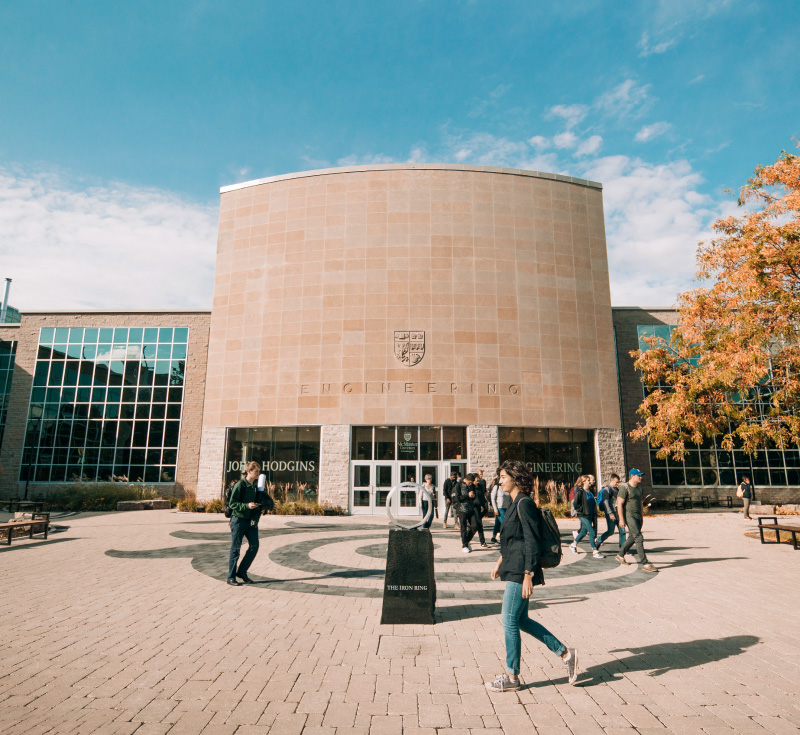
John Hodgins Engineering Building
The John Hodgins Engineering Building is the first Engineering building built and an iconic part of our community. It hosts various labs, lecture halls, departments, and student spaces, and is home to our very own Iron ring.
The Iron Ring is given to all students who have graduated from an accredited Engineering program at a Canadian University. The story of the ring comes from a collapsed bridge in Quebec which fell because of engineer’s prioritizing cost over safety. The rings were originally repurposed from the iron salvaged from the bridge and is worn on the pinky of your dominant hand for as long as you’re working in the engineering profession. The ring serves as a reminder to the engineer and others of the engineer’s obligation to live by a high standard of professional conduct.
TAP into the Mac Eng experience!
Chat with students from the Faculty of Engineering on The Ambassador Platform and discover what makes our #FireballFamily community so incredible.

